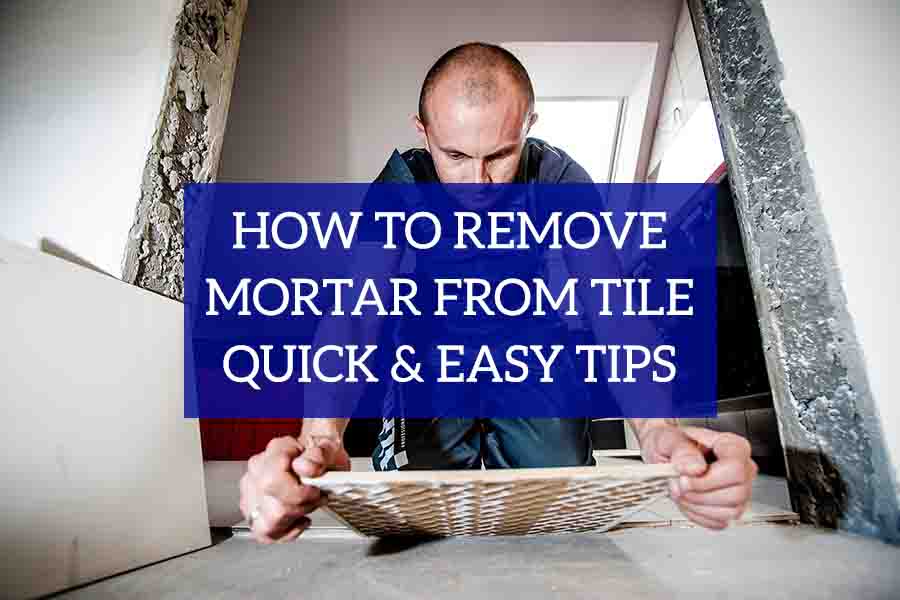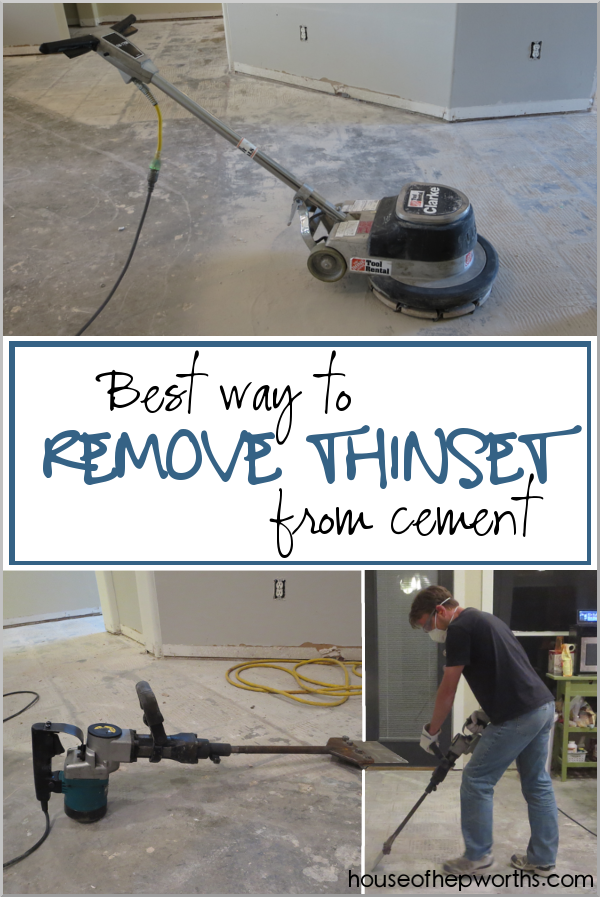
To remove mortar from tile, first soak the area with water and then gently scrape away the softened material. Use a vinegar solution for tougher mortar stains.
Removing mortar from tile can be a necessary step during a home renovation or after laying down new tiles. Mortar, the bonding agent used to secure tiles in place, can sometimes be left behind as a residual haze or as larger clumps.
This leftover debris not only detracts from the appearance of your flooring or walls but can also cause damage if not removed properly. Your approach to the task should be methodical and gentle to avoid any damage to the tile surface. A combination of water, vinegar, and appropriate scraping tools are your best allies in restoring your tile’s original luster. Following this simple but effective method will ensure your tiles are clean and preserve their quality.

Credit: www.houseofhepworths.com
Ready, Set, Prep!
Freshly laid tiles can transform a space, but mortar spillage is often part of the process. Before gracing your space with elegance, those tiles demand a clean start. Let’s tackle the prep work for a flawless tile surface with Ready, Set, Prep!
Gather Your Tools
Before diving into mortar removal, assemble the necessary tools:
- Chisel or scraper
- Bucket of water
- Sponge
- Stiff brush
- Hammer or mallet
- Rubber gloves
- Vinegar or commercial cleaner
A chisel and hammer break up large bits. The bucket, sponge, and brush clean residues. The cleaners remove tough stains.
Safety First: Gear Up
Protecting yourself is as crucial as the right tools. Always put on:
- Safety goggles to shield your eyes
- Work gloves to protect your hands
- Dust mask to avoid inhalation of particles
Wearing appropriate safety gear prevents injury and ensures a smooth, safe work process.

Credit: www.wikihow.com
Identifying Mortar Types
Identifying the type of mortar is key to a successful tile removal process. You need to know what you’re dealing with to choose the right tools and methods. This section covers two common mortar types you may encounter.
Understanding Thinset Mortar
Thinset mortar is widely used in tiling. It forms a strong bond and is ideal for floor tiles where heavy foot traffic is common. Here’s what you need to know about thinset:
- Comprised mainly of cement, fine sand, and a water-retaining agent
- Typically requires a chisel, hammer, or an electric hammer tool for removal
- Becomes very hard once cured, making it a challenge to remove
Mastic Mortar Characteristics
Mastic mortar is another adhesive option for tiles. It’s known for its sticky consistency. Below are its characteristics:
- Suitable for wall tiles in dry areas
- Has a creamy texture and comes pre-mixed
- Softer than thinset, making it easier to remove with less aggressive tools
Initial Mortar Removal
Welcome to the Initial Mortar Removal guide, a crucial first step for breathing new life into your tiles. Whether you’re renovating an old space or correcting a recent mishap, removing old mortar is essential for a smooth installation. Let’s dive into effective methods to start this process.
Soaking The Tiles
Begin with a simple yet powerful action: soaking the tiles. This method is especially great for loosening the mortar, making the scraping off a lot easier. Follow the steps below to soak your tiles efficiently:
- Fill a bucket or sink with warm water.
- Submerge the tiles completely.
- Let them soak for several hours, preferably overnight.
After a good soak, tiles are typically more compliant, and mortar starts to weaken, simplifying the removal.
Gentle Scraping Techniques
Post-soak, adopt gentle scraping techniques for mortar removal. This protects the tile’s surface. Use the right tools and methods:
- Hold a plastic putty knife at an angle.
- Gently scrape off the mortar without digging into the tile.
- For stubborn spots, apply slight pressure in a back-and-forth motion.
Remember, patience is key. Rushing the process may damage the tiles. Gentle, steady motions achieve the best results.
Chemical Solutions To Dissolve Mortar
Removing mortar from tile can be tricky, but chemical solutions offer effective results. These specialized solutions soften and dissolve mortar, making it easier to remove. For a safe and successful clean, select the right chemical and follow application guidelines.
Choosing The Right Chemical
Several chemicals can dissolve mortar.
- Muriatic acid, a popular choice, is highly effective.
- Phosphoric acid cleaners also work well, and are less harsh.
- For eco-friendly options, citrus-based removers are available.
Consider tile material and choose a product accordingly. Test in a small area to ensure no damage.
Application And Precautions
Apply chosen chemical with care.
- Wear protective gear: gloves, mask, goggles.
- Ensure adequate ventilation in the room.
- Follow manufacturer’s instructions for application.
- Use a brush or sponge to apply the solution to mortar.
- Let it sit as directed, usually a few minutes.
- Scrub gently with a bristle brush.
- Rinse the area with water and wipe clean.
Remember, safety is key. Chemicals can harm skin and eyes. Always prepare and apply with attention and care.
The Power Of Mechanical Tools
When removing mortar from tile, mechanical tools bring might and precision to your project. They offer a blend of power and control that can make your task easier and faster. In this section, we explore the mechanical aides that can help you say goodbye to stubborn mortar.
Handheld Options For Detail Work
Handheld tools are perfect for detail work because they give you accuracy and agility. Here are some of the top handheld options:
- Chisel and Hammer: Use these to chip away mortar manually.
- Grout Saw: Effective for cutting out mortar in small areas.
- Oscillating Tool: With the right blade, it’s ideal for precision.
- Scraper: Scrapes off mortar without damaging the tile.
For tighter spaces, these tools can be indispensable. They allow for meticulous work without causing harm to the tile.
Electric Power Tools For Efficiency
To save time and energy, electric power tools stand out. Below are powerful allies in mortar removal:
| Tool | Use |
|---|---|
| Angle Grinder | Perfect for grinding away tough mortar. |
| Rotary Hammer | Drills out mortar efficiently. |
| Hammer Drill | Combines drilling and chiseling action. |
| Demolition Hammer | Brings force to larger areas. |
Each tool offers a boost in productivity, especially for larger projects. They reduce fatigue and increase the pace at which you can work.
Finishing Touches
With your tile free from excess mortar, it’s time for the finishing touches. These final steps ensure a professional and clean look. They make your tile ready to shine in its newly laid glory. Let’s tackle the crucial last stages: sanding for smoothness and final cleaning and inspection.
Sanding For Smoothness
Once the mortar is off, you may notice slight rough patches. Sanding is key to a silky surface. Use a fine-grit sanding sponge and gently rub over the tile. Always wear protective gear like masks and goggles. Keep a light touch to avoid scratching the tile.
- Gather the right tools: fine-grit sanding sponge, safety gear.
- Safety first: wear a mask and goggles.
- Gentle motions: rub the sponge in circles over rough spots.
Final Cleaning And Inspection
Cleaning removes any dust from sanding. A damp cloth can pick up residual powder. Wipe the tiles in a circular motion. Then, inspect each tile carefully. Look for smoothness and any missed spots. Repeat sanding if necessary.
| Step | Action | Tips |
|---|---|---|
| 1 | Wipe down tiles | Use a damp cloth, circular motion. |
| 2 | Inspect tiles | Check for smoothness, residual mortar. |
| 3 | Repeat if needed | Sand again for any rough patches. |
Final step: Give the tile time to dry completely. Admire your work as a job well done.
Prevention And Future Maintenance
Keeping your tile free of mortar not only maintains its beauty but also extends its life. To ensure a clean surface, start with the right installation and regular upkeep. Let’s dive into some effective preventative measures.
Best Practices For Tile Installation
Avoiding mortar mishaps begins at installation. Follow these guidelines:
- Use spacers to keep tiles even and prevent mortar overflow.
- Ensure proper adhesive application with the right tools.
- Employ cleaning as you go to remove excess mortar promptly.
- Seal the tiles if necessary, to protect against future staining.
Regular Cleaning To Avoid Mortar Build-up
Staying on top of tile maintenance is key. Weekly measures safeguard against mortar build-up.
Use gentle cleaners and soft cloths to wipe surfaces. Rinse with water after cleaning. For tougher build-up, a plastic putty knife helps without scratching. Mix water and vinegar for a natural solution, and remember to dry tiles well to prevent water spots.
Credit: diy.stackexchange.com
Frequently Asked Questions On How To Remove Mortar From Tile
What Is The Best Way To Clean Mortar Off Tiles?
The most effective method to clean mortar from tiles involves using a damp sponge for fresh mortar or a muriatic acid solution for hardened mortar. Always wear gloves and eye protection. Gently scrub the area without damaging the tile surface.
Can Vinegar Remove Mortar From Tiles?
Yes, vinegar can help remove mortar from tiles. Create a solution of equal parts water and white vinegar. Apply it to the affected area, let it sit for a few minutes, then scrub gently with a soft brush. Rinse with clean water afterwards.
Is It Possible To Remove Dried Mortar Without Damaging Tiles?
It is possible to remove dried mortar without harming tiles by cautiously using a wooden or plastic scraper followed by a damp cloth. For stubborn mortar, use a specialized cleaning product designed for tile cleaning. Always test a small area first.
How Long Should I Wait To Remove Mortar After Tiling?
You should remove excess mortar from tiles as soon as possible, typically within 24 hours, while it’s still relatively soft. Waiting longer may result in the mortar hardening, making the removal process more difficult and time-consuming.
Conclusion
Removing mortar from your tiles restores their original beauty and prevents damage to your flooring. With the right tools and a gentle hand, you can effectively achieve a clean surface. Remember, patience is key—rush the process, and you might harm the tiles.
For pristine, mortar-free tiles, follow the steps outlined, and revel in the results of your hard work.




















